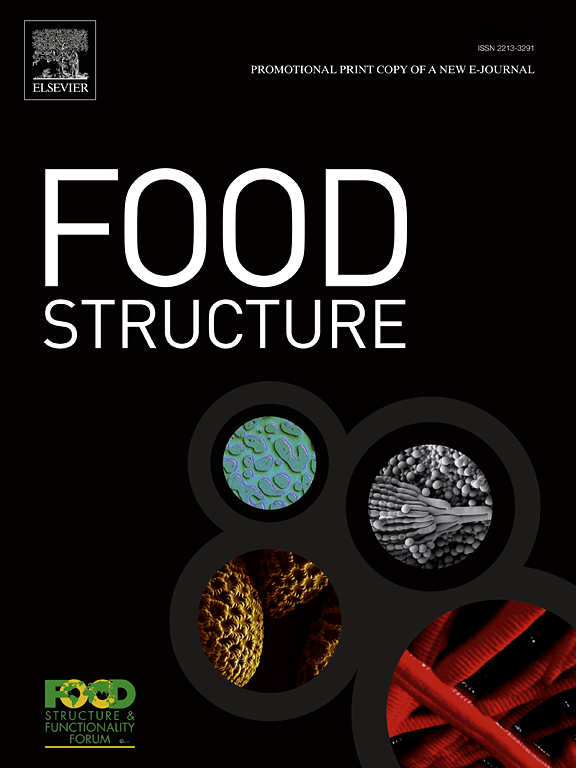Production of novel pasta filata analogs containing pea protein isolate using a direct steam injection cooker stretcher: Changes in microstructure and texture
IF 5.9
3区 农林科学
Q1 FOOD SCIENCE & TECHNOLOGY
引用次数: 0
Abstract
Stretched curd has a very characteristic structure, and unique melting and stretching properties. This research explored how the addition of pea protein isolate (PPI) may modify the microstructure and rheological properties of a stretched curd made with rennet-casein. Model cheese analogs were obtained by hydrating protein powders together with palm oil and pre-gelatinized maize starch, using different PPI/casein ratios The structure was formed using a direct steam injection cooker-stretcher. Differences in microstructure were observed using confocal microscopy and X-ray tomography, and rheological properties were evaluated using small and large amplitude oscillatory rheology. Cheese containing PPI had a higher elastic modulus compared to the rennet-casein control, a more brittle structure, and showed a change in melting behavior. Addition of 30 % of PPI already showed differences in the lipid droplet distribution, while still maintaining an anisotropic structure. At 50/50 PPI-casein protein ratios the structure was instead that typical of emulsion filled gels. This study demonstrates how by replacing rennet casein with PPI it is possible to modulate the structural features of cheese analogs.
用直接蒸汽喷射锅拉伸器生产含有豌豆分离蛋白的新型丝状意大利面:微观结构和质地的变化
拉伸凝乳具有很有特色的结构,具有独特的熔融和拉伸性能。本研究探讨了添加豌豆分离蛋白(PPI)如何改变凝乳酶-酪蛋白拉伸凝乳的微观结构和流变性能。将蛋白粉与棕榈油和预糊化的玉米淀粉,以不同的PPI/酪蛋白比例水合得到模型奶酪类似物,结构采用直接蒸汽注入蒸煮拉伸机形成。使用共聚焦显微镜和x射线断层扫描观察微观结构的差异,并使用小振幅和大振幅振荡流变学评估流变学特性。与凝血酶-酪蛋白对照相比,含有PPI的奶酪具有更高的弹性模量,更脆的结构,并表现出融化行为的变化。添加30% %的PPI后,脂滴分布已出现差异,但仍保持各向异性结构。在ppi -酪蛋白比例为50/50时,结构与典型的乳状填充凝胶相反。这项研究证明了如何用PPI取代凝血蛋白酪蛋白,有可能调节奶酪类似物的结构特征。
本文章由计算机程序翻译,如有差异,请以英文原文为准。
求助全文
约1分钟内获得全文
求助全文
来源期刊

Food Structure-Netherlands
Chemical Engineering-Bioengineering
CiteScore
7.20
自引率
0.00%
发文量
48
期刊介绍:
Food Structure is the premier international forum devoted to the publication of high-quality original research on food structure. The focus of this journal is on food structure in the context of its relationship with molecular composition, processing and macroscopic properties (e.g., shelf stability, sensory properties, etc.). Manuscripts that only report qualitative findings and micrographs and that lack sound hypothesis-driven, quantitative structure-function research are not accepted. Significance of the research findings for the food science community and/or industry must also be highlighted.
 求助内容:
求助内容: 应助结果提醒方式:
应助结果提醒方式:


